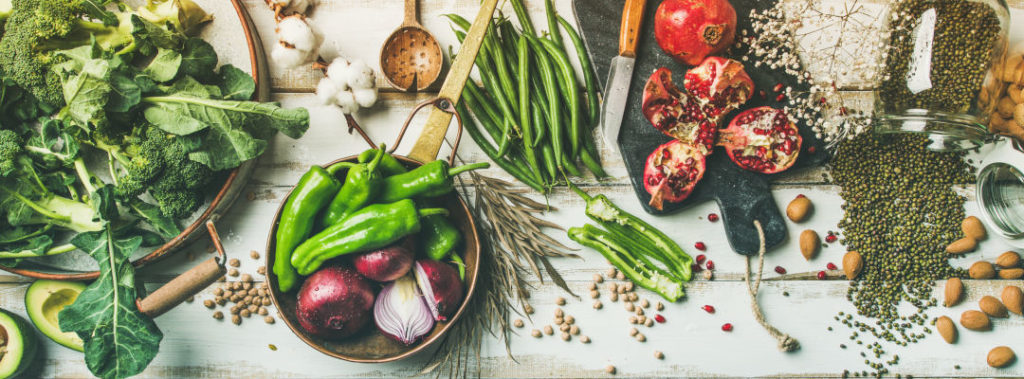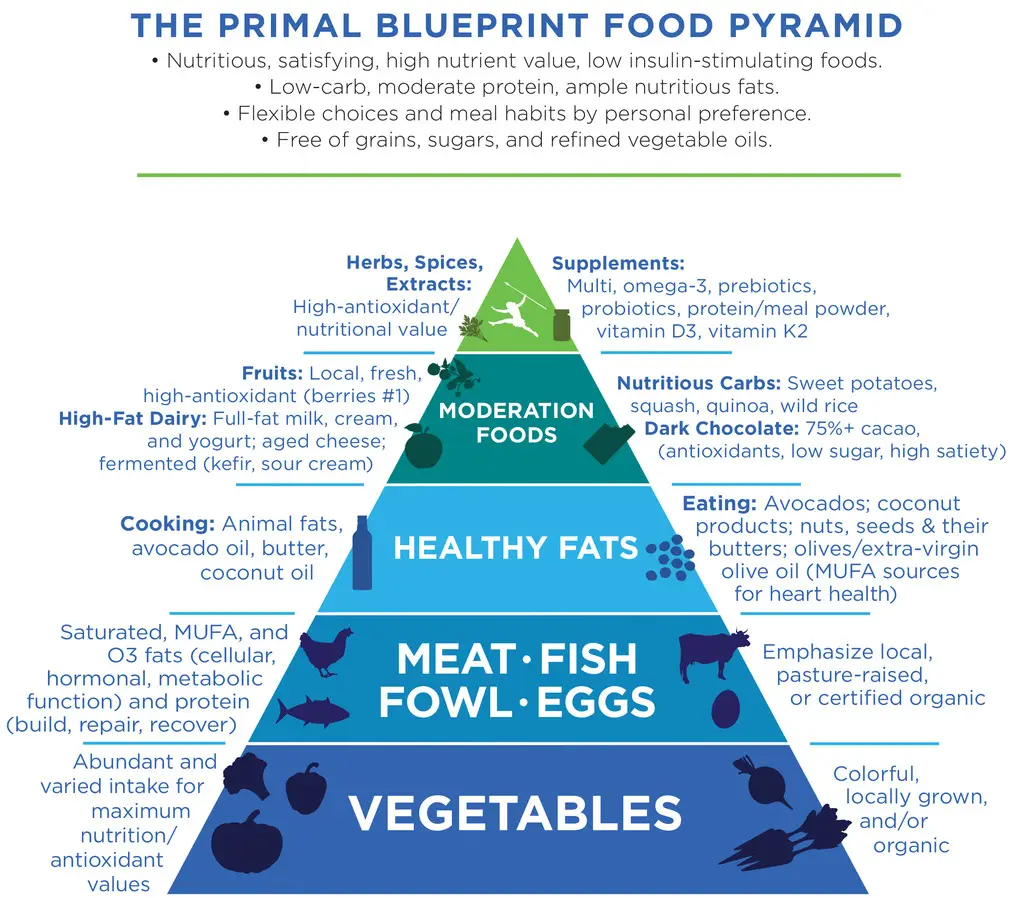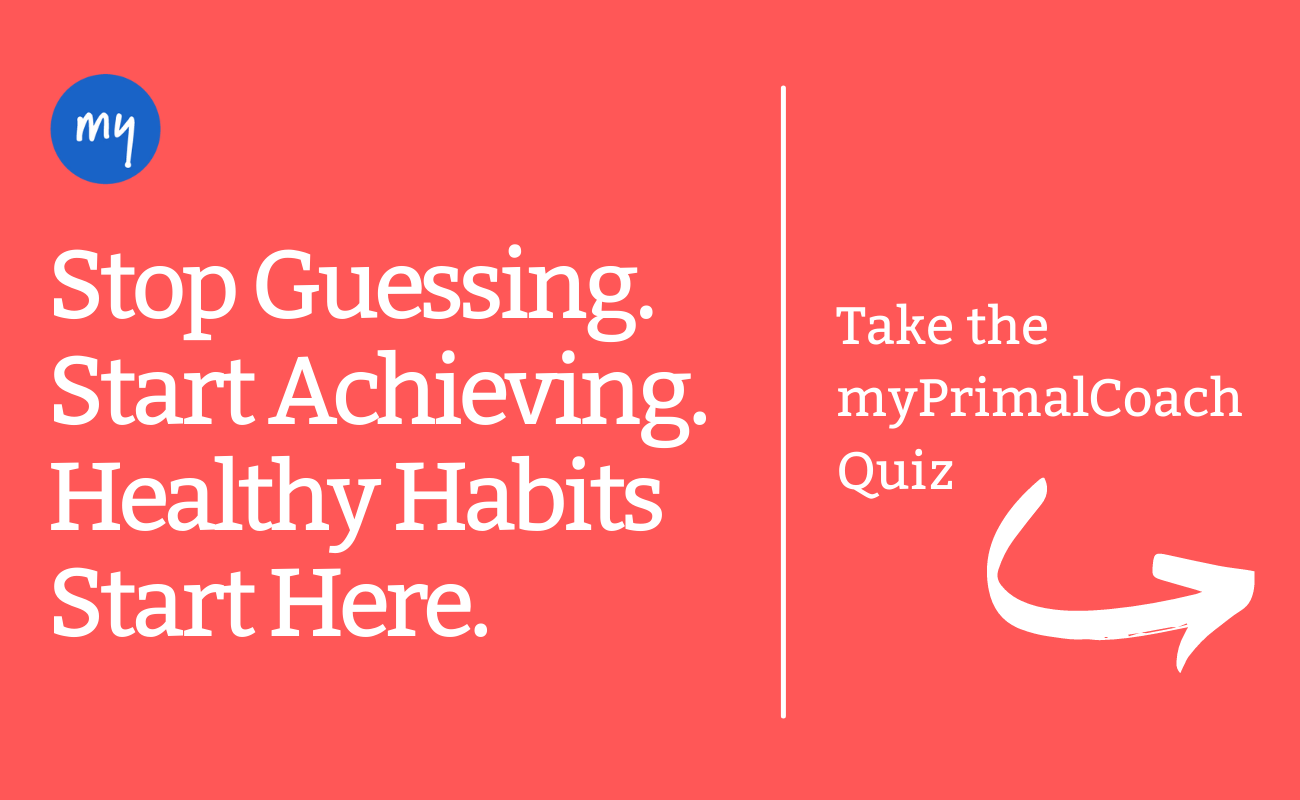Primal eating has a reputation for being meat-focused. But many of the foundational tenets of primal eating are aligned with those of veganism and vegetarianism. Let’s take a look at the basics of each of these diets, and then explore their common ground.

Primal Eating 101

Primal eating is designed to mimic, as closely as possible, the dietary patterns of our hunter-gatherer ancestors. Back in the day, humans subsisted on a diet high in protein, low in carbs, full of vegetables, fruits, and healthy fats, and free of grains, sugars, refined vegetable oils, and heavily processed foods. And so, the thinking goes, should we.
While meat—including fish, fowl, and eggs—is heavily emphasized in the primal diet, vegetables form the crux. It’s all about eating satisfying, nutritious, real food.
Vegetarianism 101
Vegetarians refrain from eating meat, fish, poultry, and sometimes animal byproducts, but as different variations of vegetarianism have come into favor, there’s quite a bit of wiggle room.
For example, there’s the lacto-ovo vegetarian who doesn’t eat meat, fish, or poultry but will consume eggs and dairy products. The lacto-vegetarian won’t touch meat, fish, poultry, or eggs but will eat dairy. And the pescatarian won’t eat meat or poultry but will eat fish, eggs, and dairy.
Veganism 101
As a stance against animal cruelty, vegans won’t eat or wear any meat or animal-derived products, including honey. Foods that are produced using animal byproducts, such as refined white rice and some wines, are also off limits. Household and personal items are likewise cruelty free.
Vegans eat beans, legumes, grains, vegetables, fruits, and all the different types of food they can create when combined in inventive ways, including vegan burgers, vegan ice cream, vegan hot dogs, etc.
Can These Diets Get Along?
Primal, vegetarian, and vegan diets have several yums in common: whole foods, vegetables, and fruits. While the menu may be a bit more limited when you combine primal eating with one or the other of these plant-based diets, it’s still possible to lean towards eating according to your hunter-gatherer nature while maintaining your vegetarian or vegan preferences.
Here’s a sample list of foods that are both primal and vegetarian/vegan approved:
Leafy greens and non-starchy vegetables:
- Broccoli
- Brussel sprouts
- Kale
- Peppers
- Onions
- Carrots
- Tomatoes
- Cauliflower
- Celery
- Mushrooms
Starchy vegetables and fruits:
- Potatoes
- Sweet potatoes
- Yams
- Turnips
- Zucchini
- Apples
- Bananas
- Oranges
- Pears
- Avocados
- Strawberries
- Blueberries
Protein sources:
- Almonds
- Macadamia nuts
- Walnuts
- Hazelnuts
- Sunflower seeds
- Pumpkin seeds
- The occasional bean or legume
Healthy fats:
- Olive oil
- Coconut oil
- Avocado oil
- Almond oil
- Butter/ghee
Grains:
- Wild rice
- Sprouted grains
7 Tips for Eating Like a Primal Vegetarian
When embarking on any new diet, remember the 80/20 rule. If we strive for 100% perfection, we’re setting ourselves up for disappointment. Instead, shoot for 80% perfection, and give yourself some room to experiment, explore, and indulge on occasion.
1. Eat Real Food
The primal diet emphasizes eating real food. Vegetarian and vegan diets, however, can be associated with highly processed, packaged foods, like veggie burgers, veggie corn dogs, veggie cold cuts, veggie chicken nuggets…and soy, all day, every day. There’s a better, and much healthier, way to go vegan.
Eat real food! Yes, that means more time spent preparing and cooking, but the health benefits of eating whole foods that haven’t been created in a lab are worth it.
2. Eat Plants
Vegetarians and vegans also have a reputation for being a little pasta and rice obsessed. Be true to your diet’s namesake and eat more plants for goodness’ sake! Cutting back on grains—we have a few options we’ve included below—will probably leave you craving your comfort foods. Increase your intake of vegetables to retrain your taste buds and calm those cravings.
3. Throw Away Refined Vegetable Oils
Highly refined vegetable oils, including canola, sunflower, safflower, corn, and soybean oils, have been stripped of nutrients, oxidize easily, and are high in omega-6s, which aren’t the kind of omegas vegetarians and vegans need more of (those are the omega-3s). Avoid these cooking oils!
Instead, cook and flavor with avocado oil and extra virgin olive oil, both rich in the heart-healthy monounsaturated fatty acid oleic acid; coconut oil, rich in medium-chain triglycerides (MCTs); and grass-fed butter or ghee if you are a vegetarian who eats dairy.
4. Eat Primal-Approved Grains
The primal diet recommends ditching grains because of the high amount of antinutrients they contain. But we know giving up grains entirely is tough, especially when you’re not eating meat to fill you up. Sure, there are sweet potatoes, bananas, tigernuts, and tons of other delicious fill-me-ups to try, but there are also some primal-approved grains you can eat in moderation: wild rice and sprouted grains.
Sprouted grains are high in folate, soluble fiber, vitamins C and E, and antioxidants. Sprouting reduces the amount of antinutrients in the grain, like gluten, tannins, phytic acid, and enzyme inhibitors. Wild rice is high in nutrients, but also antinutrients—for this reason, soak and ferment prior to eating.
5. Eat Fermented Soy
Soy makes up a large portion of plant-based diets, as many vegans and vegetarians turn to soy as a substitute protein for meat. While soy isn’t as high quality of a protein as animal protein, it’s still considered a complete protein, and you’ll be doing your body a solid if you eat it in fermented form, like natto, tempeh, and soy sauce (low sodium, of course). When you ferment soy, you unlock isoflavones and all their health benefits, such as protection against age-related diseases and cancer.
6. Stay Open
If there’s room to be flexible with certain dietary restrictions, like eating eggs and dairy on occasion, it makes it easier to stick to a primal, plant-based diet. Eggs from pasture-raised chickens contain omega-3s, choline, DHA, protein, cholesterol, vitamin B12, and other critical nutrients that are hard to come by when eating a strict vegetarian or vegan diet. And dairy products produced from grass-fed cows contain a moderate amount of saturated fat, omega-3s, calcium, protein, and probiotics.
Also, consider adding oysters to your diet. If you don’t eat meat or fish due to ethical concerns, then consider that oysters don’t have a central nervous system. Like plants, they respond to their environment and to stimuli, but there’s no brain that can register sensations or perceive harm or threat. They’re high in vitamin B12 and are the richest source of zinc you’ll ever find—two nutrients every vegetarian and vegan could use a little more of.
7. Take Supplements
There are a few supplements that vegetarians and vegans, whether primal or traditional, should consider taking as part of their daily protocol: protein powder, vitamin B12, creatine, carnosine, and algal oil.
- Protein powder: If you eat dairy, whey is always a good choice. If you don’t, then try hemp protein, rice protein, pea protein, or go straight to the source and supplement with an essential amino acid powder.
- Vitamin B12: In addition to sprinkling nutritional yeast on everything you can (salads, soups, cereals), it can help to supplement with vitamin B12 to keep your mind, heart, and reproductive health strong.
- Creatine: You have to eat muscle, like meat and fish, to get creatine, which provides energy to your muscles during exercise and recovery. It also supports cognitive function. Vegetarians and vegans can take creatine to help keep their muscles and minds in optimal condition.
- Carnosine: Found primarily in meat, carnosine is the byproduct of two amino acids (beta-alanine and histidine) that support muscle and brain health. Your body makes carnosine on its own, but studies show that vegetarians and vegans have lower levels than most other people.
- Algal oil: Omega-3s, particularly DHA, is another elusive nutrient vegans and vegetarians need to pay attention to. Rather than compromising your diet and taking fish oil, you can get DHA from algae, which is where the fish get it from in the first place.
So you see? There’s no reason you shouldn’t embrace primal eating if you’re vegetarian or vegan. It’s just a matter of reducing your reliance on processed and packaged meat substitutes and grains, and increasing your intake of whole foods. That means more vegetables and fruits, and that’s something every dieter—primal, vegetarian, or vegan—can get behind.

